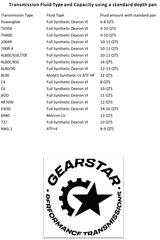Low-Revvin' Highway Fun
Low-Revvin' Highway Fun
GEAR STAR'S ALTERNATIVE TO THE 700-R4
When I'm not stuck under the hood of various magazine project vehicles in the Primedia Tech Center, I like to spend as much time as I can working on my '49 Chevy pickup. More than that, though, I really like to drive it, and not just around town. Problem was, with my 3.73 rear gear, highway cruising at speed was not as relaxing as I would have liked, if you know what I mean.
Not too long ago, I installed a 200-4R overdrive tranny into editor Rob Fortier's '53 Chevy Bel Air. I clearly recall how he was really pleased with the results-not just the installation, but also the performance benefits, which stuck in the back of my mind. Actually, that burned a hole in my brain to the effect that I began to seriously consider yanking the Turbo 350 out of the '49 and replacing it with a 200. About that time Rob said he had just run across a new transmission company, Gear Star Performance Transmission. They were offering a new 200-4R package that was hard to beat. I looked into it and found out that their Level 2 package was just what I needed for the truck.
In no way a factory replacement transmission, Gear Star's trannys are performance-proven units. The Level 2 200-4R is good for up to 450 hp, and feature an optional 10-inch, 2,500-4,500-stall torque converter that will allow repetitive dead-stop launches without hurting the trans or the converter (I opted for the milder 12-inch , 2,200-stall since I won't be launching my truck!). Standard options on the Level 2 kit include a TransGo reprogramming shift kit, Raybestos steels, ALTO Redline band and racing frictions, 0.500 boost value, and a heavy-duty pump. Gear Star also supplies a tranny cooler, AmsOil fluid, dipstick, flywheel cover, and all related components. For the 200, the lockup converter is both electronically and vacuum-controlled, and they supply the appropriate module for hookup as well. Basically, you just need to provide the tools to install.
While rumors of 200s being a weaker transmission only apply to OE applications, the Gear Star overdrive is a stout unit. When it comes to swapping one for a Turbo 350 like mine, the good thing to know is that there's no major surgery required to accomplish the job. If you have a short-shaft TH350, the only modification necessary is to move the rear mount back a few inches. For long-shaft applications like mine, you will need to have the driveshaft shortened as well as to address the mount; in my case, I just flipped the tranny cross-member around (so the mount plate faced backward) and it lined up perfectly. The lockup was wired into the ignition (key on), while the vacuum was pulled off the intake manifold. The most crucial aspect of the install, the TV cable adjustment, was done manually with the supplied cable accessories, while the cable was mounted off a homemade bracket (see photo). Finally, I shot over to Unitrax in Anaheim, California, to have the driveshaft lengthened. They have a specialized method of building 'shafts that balance without weights, offering a very accurate tube.
Once I had everything in place, hooked up, and looking like it was supposed to, I headed out to the nearby 57 freeway for a little test drive. With clear lanes on a Sunday afternoon (I didn't have the luxury of doing the install in the Tech Center during the week), I found myself doing roughly 70 mph as usual, but the tach readout was considerably lower. The 200s have a nice 2.74 First gear (compared to theTH350's 2.52), which is great with a healthy 3.73 ring-and-pinion for quick acceleration off the line, while the 0.674 Fourth overdrive is what I was really after for freeway flying. At 70 mph, I am now turning roughly 2,200 rpm-800 rpm less thatn the TH350 did. All of this, along with the firm, responsive shifts and less frequent trips to the pump, made me a happy camper.
Previously, the '49 was utilizing a used, stock Turbo 350. While there were no problems with the transmission mechanically, its lack of overdrive left a lot to be desired at freeway speeds with the 3.73 rear gear.
Removal wasn't a huge ordeal. The exhaust pipes needed to be disconnected from the header collectors; the starter taken out; and the driveshaft pulled out.
Before the transmission was taken out, it was supported securely with a floor jack and blocks of wood. The spark plugs were removed (to make turning the flywheel easier) before the converter bolts.
Lastly, with the tranny supported, the rear mount was undone. In this situation, the rear tranny cross-member is bolt-in, so its removal eases the dropping of the transmission.
Off to Unitrax in Anaheim for the driveshaft. While I said they "lengthened" the shaft (that's not really possible), Unitrax actually built a complete new one, only using the rear yoke for the original.
With everything cleared out of the way, the transmission was unbolted from the back of the engine block and yanked for the Chevy for good.
Thanks to GM, the bellhousing bolt pattern has remained the same for years, so the 200-4R bolts right up to the SBC. Even the stock flywheel was used.
Unitrax has a unique method of balancing shafts without weights. The tube is placed in their lathestyle balancer with the yokes not welded in.
While Gear Star offers a race-type stall converter for those high-hp users, I stuck with the standard 2,200-rpm version.
With a "short" TH350, the only modification necessary is to move back the rear mount. With a "long" version such as this, the driveshaft needs to be lengthened. For the mount, I just flipped the tubular cross-member around.
Dial indicators show the imbalance points.
Once the shaft is true, the yokes are fully welded in.
You may have noticed my "lazy" tranny cooler on the TH350 (there was none, just a bypass tube, which is not recommended). Gear Star was nice enough to include one in their kit; I just needed to fab up a mounting bracket.
On the opposite side of the tranny, the vacuum-electric kickdown module was hooked up and mounted off the M/C booster bracket. (Although the exhaust pipe appears to be touching the rubber line, isn't-just camera foolery.)
Even the transmission yoke is put to the balance test.
I chose to locate the cooler below the firewall at the back of the right-side fenderwell. While debris coming off the front wheel is a concern, the truck is rarely driven in poor weather or road conditions.
The last things to address before crawling out from under the truck were the kickdown (TV) cable and dipstick tubes. I opted to retain the Lokar-braided stainless dipstick.
All said and done, with new U-joints too, I was able to reconnect my Chevy's rearend to the transmission.
The old "loop" was ditched for new steel lines that feed into the high-pressure rubber lines running into the cooler.
Many companies offer brackets for TV cables on different carburetors; I made my own to work with the Lokar throttle cable and bracket assembly I already had. Basic rule of thumb when adjusting the TV: Pull throttle to wide open position and take out slack in cable. From there, drive the vehicle to get a basic idea of whether or not the tranny shifts too soon, too late, or just right. Adjust farther if necessary, but make sure you get it as close as possible.
Obviously, you'll want to make sure the unit is also topped off with appropriate fluid before taking that first test drive.


